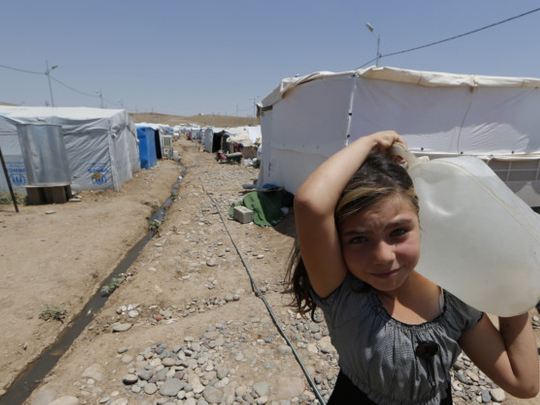
Friday last, the International Day for Refugees, brought home some memories from my childhood when I came across a refugee for the first time ever. This happened in the summer of 1948 in my hometown Latakia, Syria.
His name was Yousuf Zeidan and we were both four years old. He was a member of a Palestinian family of seven, including a four- month-old baby girl that travelled, with other refugees, all the way from the small coastal city of Akka (Acre) via Jordan.
Surprisingly, I learnt a day earlier that Yousuf’s father and mine were cousins on their mothers’ side. The family trip, through the war-damaged Allenby Bridge over the Jordan River, tragically took them 43 days to complete.
We were cramped in our modest house for longer than three months before they moved to what was to become their permanent home, the newly-built refugee camp, “Al Ramil [The Sand] neighbourhood”, in the North East outskirt of Latakia. During their stay with us we attentively listened to tales about their dangerous trip and horrific experience when they were forcibly chased out of their home by heavily armed Jewish militia.
Up till now, Yousuf Zeidan has not forgotten the little memory he carried with him to Syria as a refugee. He and his family are simply a small figure of huge population of tens of million who have become refugees the world over.
There are now refugees almost everywhere in the world, resulting from enforced migration that has contributed to shape societies through the twentieth century. These are currently stretched across a broad geographical area from Europe to the Middle East, South Asia, South-East Asia and sub-Saharan Africa. Maybe the only area which has not experience large scale population displacement, is the United States.
The world’s population is now almost divided between refugees and indigenous inhabitants. In some countries, Jordan for example, the registered Palestinian refugees are now larger than the original Jordanians. Apart from natural disasters, wars, revolutions and state formation are considered to be the main cause of displacement and population movements.
A recent comprehensive study on refugees, The Making of the Modern Refugee (Oxford), has deeply illustrated the question of refugees and its origin the world over. It also depends extensively upon oral testimony such as that of Yousuf Zeidan and his family, eye witness accounts and documented materials as well as unpublished information buried in governments, international organizations and NGOs archives.
Maybe the Middle East region is in the fore front of the world refugee question for its many heart-breaking tragedies whether in Palestine, Iraq, Jordan, Lebanon, the Sahara, the Sudan and not to forget the latest painful displacement in Syria.
As an example, Yarmouk, the largest Palestinian refugee camp in the heart of Damascus, presents us with stories unheard of anywhere in the world. Last month, 120 fourteen-year-olds children emerged from the apocalyptic area the Palestinian refugees call home since 1948, traumatically bewildered, after they were allowed to sit their public exams in the capital. Two weeks later the same children were returned to their devastated home to continue living as child victims of the ugliest war of the century.
Yarmouk is only one of the many refugee camps in Syria. They house about 550,000 registered refugees by the United Nations Relief and Works Agency for Palestine Refugees in the Near East (UNRWA) in that country.
According to UNRWA, more than 50 per cent of the refugees have been displaced by the continuing conflict with over half of the 12 Palestinian refugee camps in the country, transformed into war theatres. Beyond Syria, the situation of refugees in West Bank and Gaza is dire indeed.
The human impact of the Israeli occupation and colony expansion is multi-dimensional and profound. Many refugees are harshly forced to deal, often on their own, with home demolitions and land expropriations. Children and ordinary civilians face increased threats from the use of live Israeli ammunition. “Food insecurity in Palestine has reached 33 per cent, affecting 1.6 million people” according to UNRWA.
In the most recent and bloodiest conflict in the Middle East that civil war has created in Syria, an estimated nine million Syrians have fled their homes since the war outbreak in March 2011, taking refuge in neighbouring countries as well as within Syria itself. 6.5 million are internally displaced while about 100,000 refugees have sought asylum in Europe with a small number offered resettlement by European countries such as Germany and Sweden.
United Nations High Commissioner for Refugees UNHCR, says that more than 2.5 million have fled to Syria’s immediate neighbours Turkey, Lebanon, Jordan and Iraq. Absorbing the influx of Syrian refugees is an enormous challenge for these countries with unknown implications for the stability of the entire region.
This will make the story of refugees in the region more tragic and heartbreaking as life for some refugees began to look like normal, particularly those who live in Za’atari camp and the newly built one Azraq, in Jordan.
Both camps which will end up housing the bulk of the 600,000 Syrian refugees in the country, are some 12km away from the southern Syrian city of Dera’a, where fighting is still raging.
Unfortunately, with the opening recently of a Safeway chain super-market, refugees started to feel they are there to stay for a very long time. There is no need for cash to shop as World Food Programme (WFP) food vouchers are accepted. The shop will soon switch to pre-paid debit cards.
Mustapha Karkouti is a former president of the Foreign Press Association, London.








